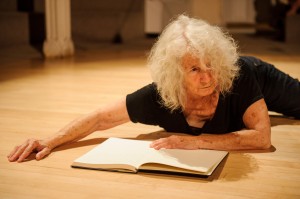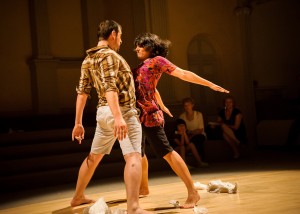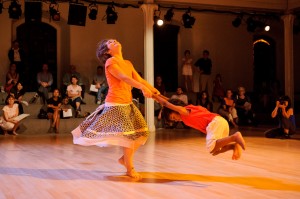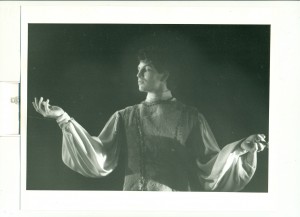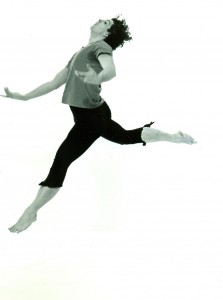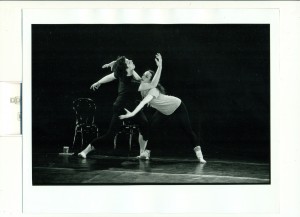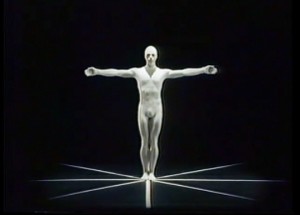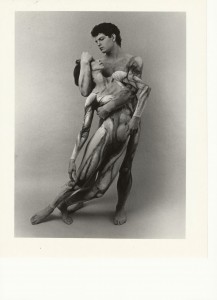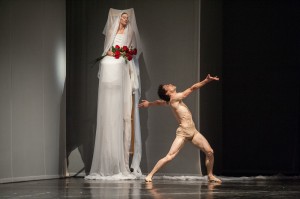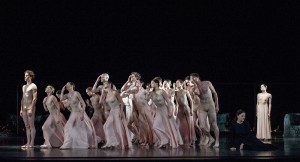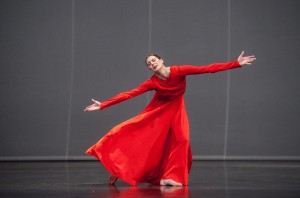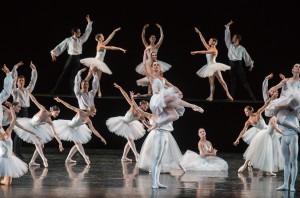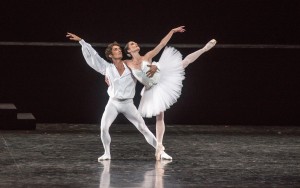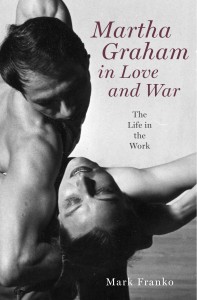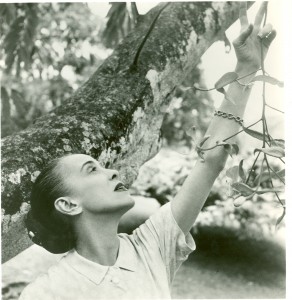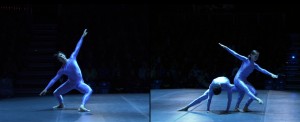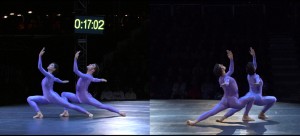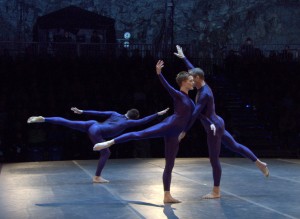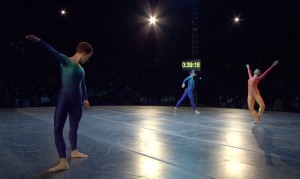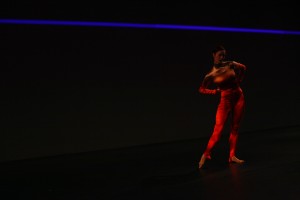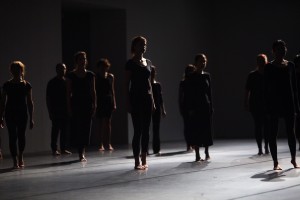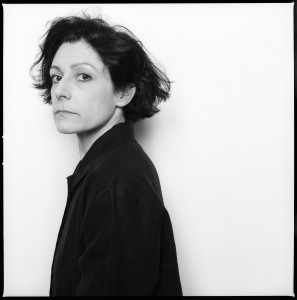
The artist Ph.D. is a new trend in higher education gaining momentum particularly in Western Europe where increasingly conservatories are merging with universities. In this context, Cristina Caprioli, Stockholm-based choreographer, is ahead of the game as she has for some time been an artist-theorist.
I caught an informal showing of her Cloth, an installation-like dance for two women under immense black cloth that seems light but, given its mass and spread, is also weighty, and able to create myriad folds. This extremely sculptural slow-motion dance was premiered at the Moderna Museet in Stockholm (April 12, 2011), but was shown again at DOCH (University of Dance and Circus) prior to a filming (November 17, 2012).
Cloth lasts about three hours as the dancers execute choreographic material that has been set, but which must be executed under this very large square dark grey rubbery material that is spread across the floor. The audience is encouraged to walk around it and look at it from various angles. One or both of the dancers emerge occasionally for air so that their forays into the fabric – singly or as a twosome – are punctuated by their sitting at the edge during which time they look at each other and wait. Once beneath the fabric, however, their bodily outlines change radically. At times they appear highly sculptural as the material takes on a myriad of folds; occasionally the positions they assume are ornamental or statuesque, and in these moments their bodies create an anonymous volume that makes them seemed carved in stone Yet, the dark color of the cloth and its spread across a wide area also suggest an oil spill, and the bodies of birds coated in oil. Sometimes, they simply disappear in a voluminous pocket of air. The changing configuration of the cloth itself is a third player in this work and exerts a particular fascination in utter silence. The images arise one by one before dissolving: the pace is steady and uneventful as there is time between each image as it is emerging, establishing itself, and subsiding back to the material.
Cristina spoke of her upcoming conference, Weaving Politics, which is the third in a series of conferences she has curated since the late 1990s. I asked about the connection between these three events.
“Talking Dancing (1997) came about because I got a grant to do something that wouldn’t be a production, but would be kind of research work; there was also the possibility to be at the Dansens Hus to do it: it was a residency grant. I felt that in the community, and in the discourse around me, there was a tremendous lack of knowledge: very few people knew about the Judson Church: who had done what when. I wanted to share this with the Swedish community. The Quattuor Albrecht Knust had just done a reenactment of Continuous Project/Altered Daily by Yvonne Rainer in France. Judson was in the air in Europe, so I invited the Knust Quartet and Yvonne, Douglas, Steve Paxton, Deborah Jowitt, Susan Foster, Sally Banes and Noel Carroll. Also, Sally Silvers and other artists. It was not so huge but it extended over a few weeks with lots of workshops and reconstructions. It was a workshop-based conference. I felt there was a lack of interest in contemporary choreography because of a lack of historical knowledge; and, I felt it was interesting for me to return to this moment. I arrived in New York in 1976 and Yvonne had already stopped doing choreography; Paxton had already left the city. I was too late then; I was trying to catch up with that.
“The only critique I got was when I said: there was perhaps not a political intention, but it became something that had a political impact. People in our community disagreed: the work was so ‘mellow,’ not radical. Again, I felt, my god, people really don’t get it. Do we need to be on the barricades to be political? This discussion on what is political already started there. I think it is still an issue.
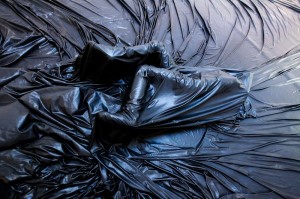
“The second conference, Movement is a Woman (2000), came later. I was just getting divorced and was on a personal journey. I had been reading a lot of Irigaray and Kristeva to catch up with feminism. And, perhaps, as the aftermath of “Talking Dancing” had displayed, unless you speak the political rhetoric that is expected, you are not political. The feminist character of dance and choreography may lie somewhere elsewhere. Something about femininity in the act of movement: “trans-genderizing” itself by continuous motion, I could say that dance does the same. I was trying to target the question of what is femininity. In what kind of dance does that come across, is it brought to the table, as the actual motive? At the moment, Rosas was very big: the work is stunning, but it is so “girlish” – a representation of something else. If felt there is more to Anna Teresa’s work than this young girl that everyone loves to look at: and also what makes it so successful. I was also trying with that conference to raise the level of theoretical thinking. It was very ambitious and I did not have enough funding or preparation to run it. But, it left some mark in this area.
“Movement is a Woman was more directed to groups of students than to the general public mixed with practitioners. I invited Wim Vandekeybus: he was doing a piece about women (he started it here). That caused a lot of reactions. People attacked me; there were meetings with the union about Wim asking the performers to take off their clothes. I felt that I was provoking something: I wanted the women to counter him, or have a critical encounter with him. But, everyone wanted to work with him, was flirting with him, etc. What really came out that these female dancers who claim to understand their self worth, at the end of the day were easily manipulated. When I spoke with Wim afterwards he said he was interested in women resisting him. Finally, I thought it was good this discussion came up.
After that, I felt it was too much of an effort to continue this. I stopped. I had a course at the University where I did smaller things: seminars with guests.
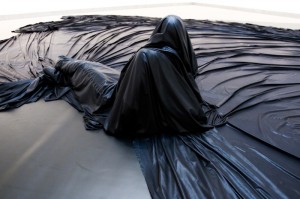
“The reason twelve years later I am doing Weaving Politics (December 14-16, 2012) is that I applied for a research program feeling again it is time now again to do this kind of thing. The scene has changed: there was a possibility to apply for such funding that includes things like a conference or symposium. It started off again from the question of politics: but I wanted to be more precise about it. One thing led to another. This is the year of human rights year in Sweden. Everyone has been talking about Raoul Wallenberg. The question of the body and the human came together with the questions of rights: why is it that when the body stands up erected, he or she is right. It was about time Forsythe was invited to Sweden not to do his neo-classical work (seen in the ballet) but to see his installation-oriented work. He will bring Human Writes to Sweden for this first time. It should be a time for choreography and dance to put herself or itself in a more spectacular and official power discourse. For this reason I needed big names. (A conference is what it is: a performance. The important thing is to read the work: we invite them to have a performance of speaking their writing. They speak by writing but then they speak again). To study and to embrace or problematize what these people who have been invited stand for can be done by reading their books or doing seminars on them, one by one. The symposium as a huge spectacular event brings about me putting them on a stage for dance. By bringing them together, the most tangible political action or act of my entire enterprise is actually to get these people onto the Dansens Hus stage. It is the place where the so-to-speak not normative but still official dance is happening: big companies from abroad come there. It is the official space where dance has most power. But, in reality, it has become incredibly commercialized.
“It feels really good that this act of politics arrives nomadically, we invade the space of power, and then we leave. We have to temporarily invade their territory. We do not want to take it over, we just want to invade it (force them to present us). It is as if I were forcing (also by inviting Forsythe) them to look at his work that resembles more than we do than what they expect. I am using him to legitimize more our discourses of choreography that do not belong to the official stage.”
Cristina explained how she originally wanted to produce Forsythe’s Human Writes in the Stockholm City Hall on the banquet tables where the Nobel Prize award ceremony always takes place.
“There has been a lot of hype because I invited Slavoj Zizek. Of course, I am interested in him for himself; but, without him, the symposium stands (Zizek has to cancel because of health issues). The public will be a mixture of people in culture, audience, people from theater and visual arts – a very heterogeneous mix.
Who is doing politics from what place? This is the question of the conference. When is it staged, when pursued, when rewritten?
This programming work is informing my own work. Who speaks from where doing what gestures and what does it mean to place choreography within a public discussion? Kristeva wrote in 1974: “contemporary theater does not take [a] place”. The specificity of what choreography does is the limited capacity it has; but if it dares to remain within its own limits it will have a tremendous possibility of reverberation or consecutive folds or rings on the water…. The cause and effect between political change and ethical impact will not be direct but nevertheless if choreography endures its own limitations, it will set in motion a series of effects. The artist does not need to go directly to the political situation: the artist must allow the folding effects to reach whatever space, location, circumstance it needs to be used at.
To say these things is almost taboo here. I don’t mean it is elite or removed from reality. The two fields – dance and politics — do not need to act upon each other directly. I don’t know if it will be possible to do this as a conference. There is the danger of popularizing the subject, making it flashy.
Dansens Hus has appropriated the theme: which is good. But, it has also popularized the theme. Let’s bring these popularized concepts, especially in Sweden everything is about rights (not about duties) is taken for granted. No one is questioning it. I also wanted to open it up to the general public: to have a catchy word no one will be scared of. The symposium wants to be specific but also stay available to a less-informed audience.
I got some harsh critique from the dance community because they think Forsythe is definitely not political. The writing is an alibi of western powers that they are acting according to these principles. I am pointing to the critique of how human rights are implemented in the contemporary world.
Hopefully, this encounter will lead to a post-scriptum: the actual discussion will happen afterwards. Perhaps in another meeting (more informally): perhaps we can all go to Ljubljana and visit Zizek to ask him our questions.”
For more information on the conference: http://www.weavingpolitics.se/participants/cristina-caprioliccap/
